Related Research Articles
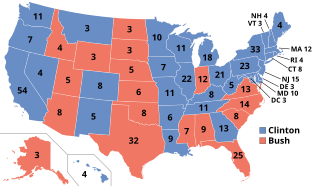
The 1992 United States presidential election was the 52nd quadrennial presidential election. It was held on Tuesday, November 3, 1992. Democratic Governor Bill Clinton of Arkansas defeated incumbent Republican President George H. W. Bush, independent businessman Ross Perot of Texas, and a number of minor candidates.

The 1988 United States presidential election was the 51st quadrennial presidential election. It was held on Tuesday, November 8, 1988. Incumbent Vice President George H. W. Bush, the Republican nominee, defeated Democratic Massachusetts Governor Michael Dukakis. This was the first presidential election since 1940 in which a party won the presidency three consecutive times.
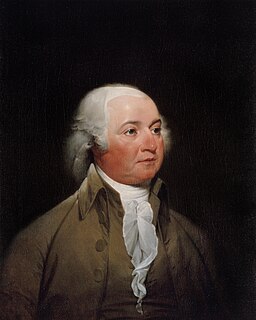
The 1796 United States presidential election was the third quadrennial presidential election. It was held from Friday, November 4 to Wednesday, December 7, 1796. It was the first contested American presidential election, the first presidential election in which political parties played a dominant role, and the only presidential election in which a president and vice president were elected from opposing tickets. Incumbent Vice President John Adams of the Federalist Party defeated former Secretary of State Thomas Jefferson of the Democratic-Republican Party.
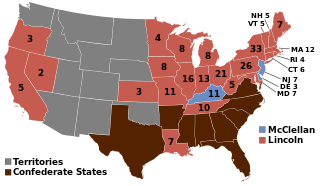
The 1864 United States presidential election, the 20th quadrennial presidential election, was held on Tuesday, November 8, 1864. In the midst of the American Civil War, incumbent President Abraham Lincoln of the National Union Party easily defeated the Democratic nominee, former General George B. McClellan, by a wide margin of 212–21 in the electoral college, with 55% of the popular vote. For the election, the Republican Party and some Democrats created the National Union Party, especially to attract War Democrats.
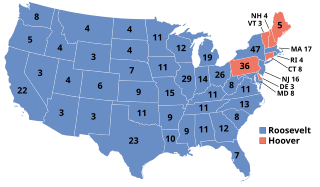
The 1932 United States presidential election was the 37th quadrennial presidential election, held on Tuesday, November 8, 1932. The election took place against the backdrop of the Great Depression. Incumbent Republican President Herbert Hoover was defeated in a landslide by Democrat Franklin D. Roosevelt, the Governor of New York and the vice presidential nominee of the 1920 presidential election. Hoover was the last elected incumbent president to lose reelection until Jimmy Carter 48 years later. The election marked the effective end of the Fourth Party System, which had been dominated by Republicans.

The 1944 United States presidential election was the 40th quadrennial presidential election. It was held on Tuesday, November 7, 1944. The election took place during World War II. Incumbent Democratic President Franklin D. Roosevelt defeated Republican Thomas E. Dewey to win an unprecedented fourth term. Until 1996, this would be the last time in which an incumbent Democratic president would win reelection after serving a full term in office.
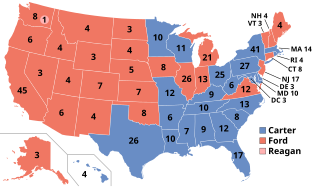
The 1976 United States presidential election was the 48th quadrennial presidential election. It was held on Tuesday, November 2, 1976. Democrat Jimmy Carter of Georgia defeated incumbent Republican President Gerald Ford from Michigan. Carter's win represented the lone Democratic victory in a presidential election held between 1968 and 1992.

The 1984 United States presidential election was the 50th quadrennial presidential election. It was held on Tuesday, November 6, 1984. Incumbent Republican President Ronald Reagan defeated former Vice President Walter Mondale, the Democratic candidate.

The 1992 presidential campaign of Bill Clinton, then Governor of Arkansas, was announced on October 3, 1991 in Little Rock, Arkansas. After winning a majority of delegates in the Democratic primaries of 1992, the campaign announced that then-junior Senator from Tennessee, Al Gore, would be Clinton's running mate. The Clinton-Gore ticket went on to defeat Republican incumbent President George H. W. Bush and Vice President Dan Quayle in the presidential election on November 3, 1992, and took office as the 42nd President and 45th Vice President, respectively, on January 20, 1993.

Robert "Bob" Russell is a fictional character played by Gary Cole on the television serial drama The West Wing. He is introduced as a member of Congress from Colorado, and succeeds to the vice presidency after President Bartlet nominates him following the resignation of incumbent John Hoynes.

Matthew Vincente Santos is a fictional character on the American television show The West Wing, played by Jimmy Smits. His initial appearance was as a Democratic U.S. Representative from Houston, Texas. He was later elected to succeed Josiah Bartlet as President in the final episodes of the series. According to David Remnick's biography of Barack Obama, The Bridge, and other news sources, West Wing writer and producer Eli Attie used then-Illinois State Senator Obama as a model for the character.

Arnold Vinick is a fictional character on the television series The West Wing played by Alan Alda. The role earned Alda the Primetime Emmy Award for Outstanding Supporting Actor in a Drama Series in 2006.
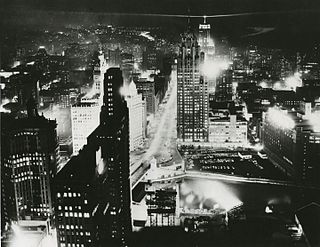
The 1956 Democratic National Convention nominated former Governor Adlai Stevenson of Illinois for president and Senator Estes Kefauver of Tennessee for vice president. It was held in the International Amphitheatre on the South Side of Chicago, Illinois August 13–August 17, 1956. Unsuccessful candidates for the presidential nomination included Governor W. Averell Harriman of New York, Senator Lyndon B. Johnson of Texas, and Senator Stuart Symington of Missouri.
This article contains lists of official and potential third party and independent candidates associated with the 1996 United States presidential election.

The 1988 United States elections was held on November 8, and elected the members of the 101st United States Congress. The Republican Party retained the presidency, while the Democratic Party retained control of Congress.

The 1952 United States presidential election in New York took place on November 4, 1952. All contemporary 48 states were part of the 1952 United States presidential election. New York voters chose 45 electors to the Electoral College, which selected the president and vice president.